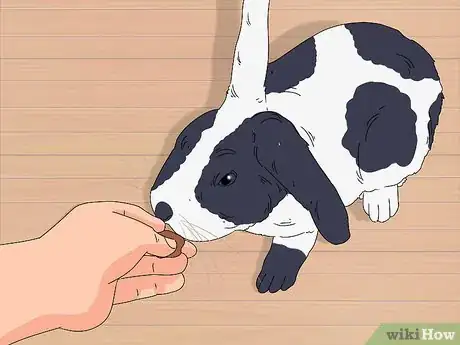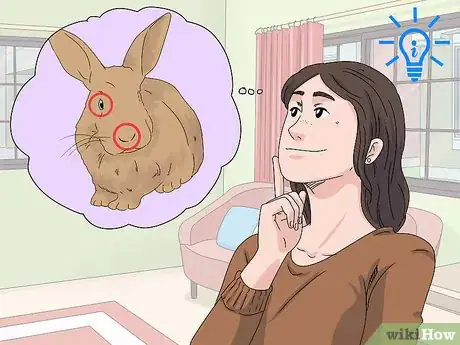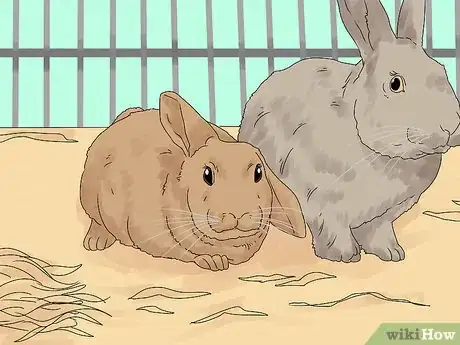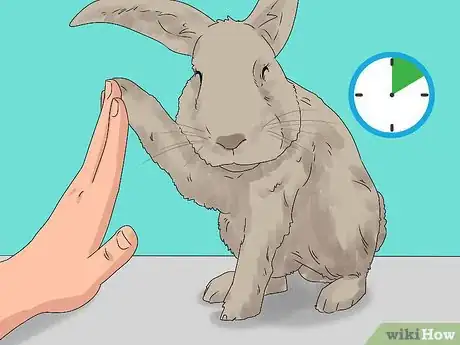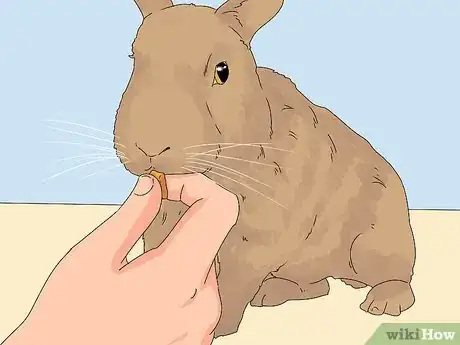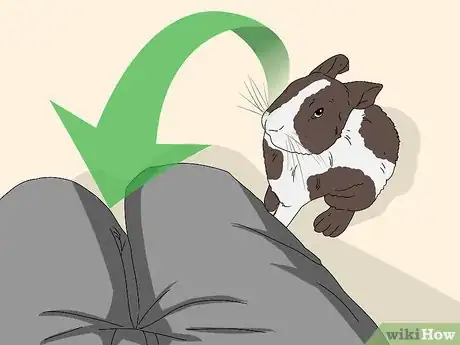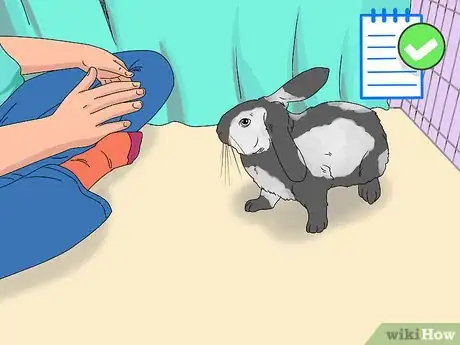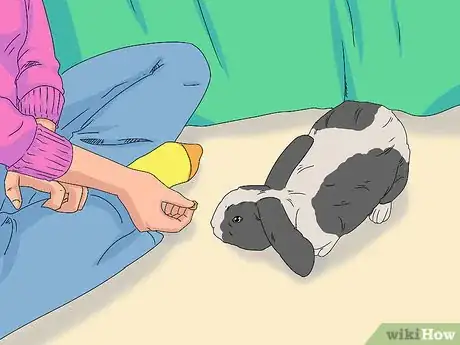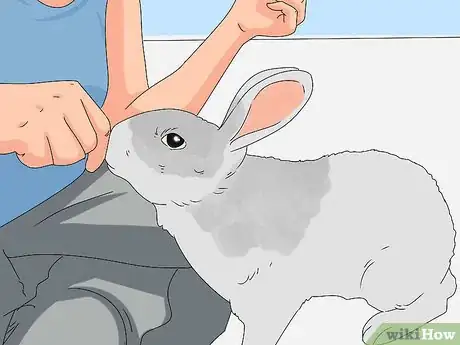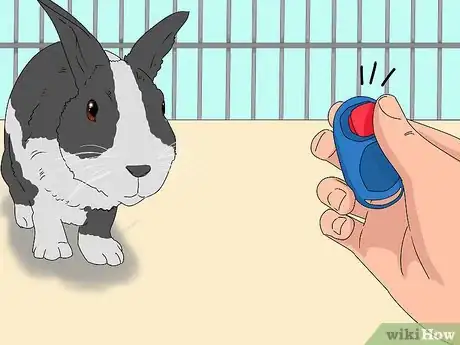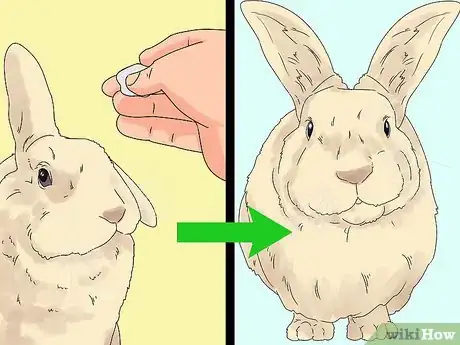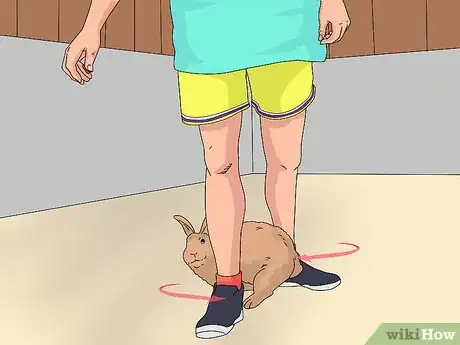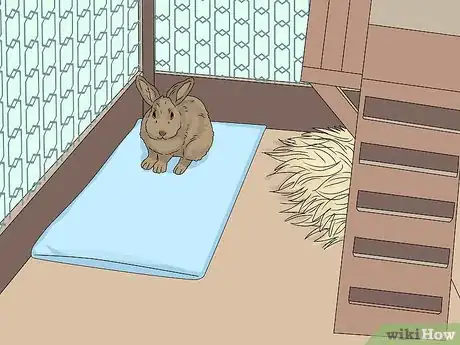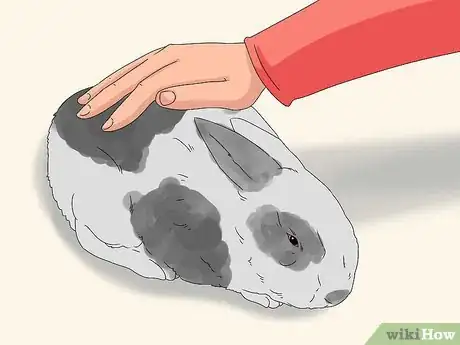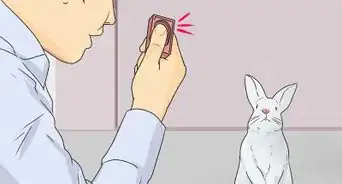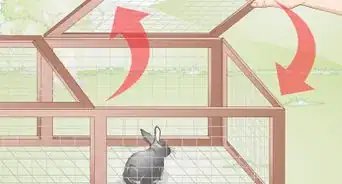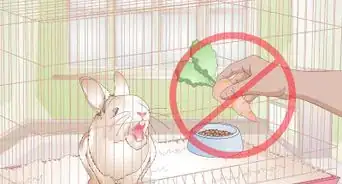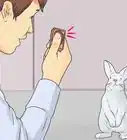This article was co-authored by Jamie Freyer, DVM. Dr. Jamie Freyer is a Licensed Doctor of Veterinary Medicine based in Washington. With over ten years of experience in clinical practice and industry, she specializes in veterinary medicine and surgery, animal behavior, and animal genetics. Dr. Freyer holds a BS in Life Science from The University of Portland and a DVM from Oregon State University.
There are 9 references cited in this article, which can be found at the bottom of the page.
wikiHow marks an article as reader-approved once it receives enough positive feedback. This article received 28 testimonials and 99% of readers who voted found it helpful, earning it our reader-approved status.
This article has been viewed 1,104,253 times.
Rabbits are very intelligent, social animals that can be trained quite easily. Unfortunately, many humans fail to train their rabbits, either because they use the wrong approach, or they don’t spend enough time on training. If you want to build a better relationship with your bunny, and train them right, you simply need to hop right in and get started!
Steps
Understanding Rabbit Behavior
-
1Understand what motivates your rabbit. Rabbits are very intelligent and eagerly respond to incentives. This means that strong punishment, such as spanking or yelling at a rabbit, won’t make it more cooperative. If you use incentives correctly, however, most rabbits will respond accordingly.
- Food is generally used as motivator, but toys may also be a reward for your rabbit.[1]
- Rabbits are prey animals, so if they feel frightened, they will usually flee and try to find somewhere to hide. If they exhibit this behavior, it means that you need to find a way to make them feel more comfortable and safer before attempting to train them.
-
2Understand how a rabbit uses sight and smell. Bunnies do not see well directly in front of their faces. Their eyes are set far apart on the head and so they see to the side and far away better than up close.
- The rabbit will use scent and whisker feedback to detect anything in the immediate environment more so than sight, so you will want to place treats under the rabbit’s nose and mouth.
- You may notice that rabbits change their head position as you get closer. This is an effort to see you better, like a person with bifocals trying to get the glasses and their eyes lined up to see.
- Rabbits are prey animals and need to see predators from far away, so that they can run and hide in time to save themselves. Because of this, before you touch it, you need to let the rabbit see and smell you. This will give you an easier time handling the rabbit. By letting it see and smell you, it can verify that you are not a predator, and therefore no danger to it.
Advertisement -
3Remember that kindness goes a long way with a rabbit. Rabbits respond to kindness and will make excellent companions who will respond positively to your voice and presence if you treat them well. While you must have your rabbit’s respect in order to train it, you’ll be most successful if your rabbit also feels loved and comfortable in your presence.
- Not all rabbits enjoy being stroked, but some enjoy it so much that stroking can be an even better incentive than food. Spend plenty of quality time petting your rabbit, and attend to all its basic needs so that it feels secure and comfortable in your home.
- Never hold your bunny by the ears! Don't hurt your rabbit. Be kind and gentle to your fluffy friend and it will respond more positively to your training.[2]
Training Your Rabbit to Follow Commands
-
1Devote plenty of time to training. For best results plan on initially devoting a little time every day to training your rabbit. Two or three short sessions of 5 to 10 minutes at a time will keep your bunny interested in learning.[3]
-
2Use your rabbit’s favorite treats. Since training is based on incentives, you’ll need to find a treat that provides the most positive response. If you don’t know what your rabbit’s favorite treat is experiment a little. You can offer a new food, in small amounts to avoid digestive upset, once a day and watch the rabbit’s response. If they leave it alone, then it won’t work as a treat, but if the bunny munches it right down, you have a winner.
- If you’re not sure if a particular food is safe for your rabbit, check with your veterinarian (one that is familiar with rabbits). Do not feed anything but vegetables, greens, or fruit to your bunny.
- If your rabbit is not used to eating much fruit or fresh greens, go easy on the amounts for a few weeks to avoid causing diarrhea or digestive upset.[4]
- Your rabbit may like Blueberries or Kale or Carrot (try shreds of carrot) as a treat.[5]
-
3Get your rabbit in position for training. Stage your training in the area and situation where and when you will want the behavior to occur. For example, if you want to teach your rabbit to jump up on your lap when called, first put it near the couch. If you want to train it to go in its crate at night, train it around the appropriate time, and make sure its crate is positioned where it will normally be.
-
4Have a plan. Start simple. Carefully plan what you want your rabbit to perform and break that task down into small steps. You will reward the rabbit after completing each new step. Once the rabbit is performing the task with regularity and confidence, give the command a name.
-
5Give your rabbit a treat immediately when your rabbit does something you want to reward. If the rabbit sits up as you lift your hand above its head as if sitting up to beg, give the treat right away to reinforce “sit up.” The reward will need to be given within 2-3 seconds of the behavior.
- If the rabbit does something else before you give the treat, you are reinforcing the wrong behavior.
- If you want to teach your rabbit to come when called, start its training by having it positioned very close to you. When it comes to you, give it the reward. Be consistent so that your fluffy companion knows why it's getting treats.
- Use the exact same commands, such as “Sit, (Your Rabbit's Name),” or “Up, (Your Rabbit's Name),” every time, so your rabbit will learn to recognize your requests and associate those exact words with getting a treat.
- Add praise to the act of giving the treat. For instance, “Good Sit” or “Good Up.”
-
6Keep providing the treats until your rabbit responds correctly nearly every time. When you’re trying to teach a new skill, don’t skimp on the rewards. You need to make sure you are thoroughly conditioning your rabbit.
- If you are training your rabbit to allow a harness to be placed, start with rewarding the bunny for going over to the harness on the floor and sniffing or touching the item. Work up to placing the harness on the bunny’s back and rewarding them for staying still. Reward the bunny for calmly allowing you to lift up a front leg then work up to placing their foot through the appropriate part of the harness. Reward as you go and move slowly. Don’t frighten or rush the rabbit. Once you have the harness in place, allow the rabbit to wear it for a few minutes at a time and take it off. Work up to having the rabbit drag the leash around the house before picking up the leash yourself.
-
7Consider using clicker training. Many people suggest using clickers to reinforce association.[6] Each time you feed the rabbit, click the clicker so that the rabbit associates the click with food. Then, when you’re training, a click from the device tells the rabbit a treat is coming.
- Try to click right as the desired behavior is happening so the animal knows what it did to get the reward. Give the rabbit a treat or something else they enjoy within a few seconds of the click for each and every time you click, even if you click accidentally. The rabbit will learn that a click means a treat and try to earn clicks.
-
8Wean your rabbit off the treats gradually. Once your rabbit has a skill down begin to give the treats less frequently. Give its reward once and then don’t the next time, or give it a treat only every few times. Eventually you may not need treats at all.
- In time, reward your rabbit with petting and toys and only use food occasionally to keep the behavior strong.
- Rabbits like gentle strokes on their heads. Do not stroke the rabbit on its body; this is alarming to a rabbit. Be patient and take things slowly to avoid creating fear in your rabbit.
-
9Reinforce the training as necessary. From time to time your rabbit may need to relearn a skill. That is, you may need to bring the incentives back. Don’t be afraid to do so.
- Never scold, punish, shout or even say "no" to the rabbit during training. This is counterproductive and will make your rabbit more fearful and delay training.
Training Your Rabbit to Use a Litter Box
-
1Figure out where your rabbit is eliminating. They naturally choose a particular spot in the cage to eliminate. Because they use the same spot repeatedly, you can use this to your advantage.
-
2Place a little of the dirty bedding in the litter box you bought for their cage. This will encourage the rabbit to use the litter box. Make sure to clean the rest of the cage after moving a bit of the dirty bedding.
-
3Place the litter box in the place the rabbit has chosen to eliminate. There are litter boxes for rabbits made to fit in the corners of cages or you can use a rectangular version if the cage is large enough. If you position is right, the rabbit should naturally continue to use the same spot, only this time it will be in the litter box.
- Of course, larger litter boxes are possible when the rabbit is enjoying “bunny hop” time outside the cage.
Addressing Rabbit Aggression
-
1Make sure your rabbit knows who is in charge. Chances are your rabbit will want to rule the house. While you can’t expect the kind of submission you can get from a dog, you must have the respect of your rabbit in order to train it.
- The most common way rabbits try to assert dominance is inappropriate nipping or biting you to try to herd you or get you to leave your sitting place. If this occurs, let out a short, loud, high-pitched squeal and either put your rabbit down on the floor (if it has jumped up where you’re sitting) or pick it up and move it out of the way from you (if it is on the floor already).[7] Do this firmly, but gently. You don’t want to hurt your rabbit or make it fear you, you simply want to assert that you are in charge. If your rabbit continues the behavior, put it in its crate for a “time-out.”
-
2Address any aggression in your rabbit. First, approach your rabbit calmly so you do not elicit a fear response from the rabbit. Hang out on the floor with your rabbit. Have some treats on the floor. Reward the rabbit for coming closer to you. Leave your hand down. If the rabbit comes up to you and does not seem afraid or does not try to bite you, try to gently stroke the rabbit's head for just a few seconds.
- If you do not back down and avoid the reflex to “run away” if the bunny charges you, the rabbit will learn that this behavior does not work to intimidate you.[8]
- Never hit the rabbit. You and your hands are the sources of food and pleasure, like petting on top of the rabbit’s head.
- If you are afraid of being injured, wear long pants, shoes, long sleeves and gloves if necessary to protect yourself from bites.[9]
-
3Investigate whether your rabbit's aggression has an underlying cause. A change in your rabbit’s behavior, including aggression, should be investigated to eliminate the chance that there is a medical issue causing the problem.[10] Consult with a veterinarian familiar with rabbits to rule out pain, for instance, as a cause for misbehavior.
- Hormones can also influence bunny behavior and having your rabbit spayed or neutered may help decrease territorial aggression, for instance.
Expert Q&A
-
QuestionAre rabbits hard to introduce?
 Jamie Freyer, DVMDr. Jamie Freyer is a Licensed Doctor of Veterinary Medicine based in Washington. With over ten years of experience in clinical practice and industry, she specializes in veterinary medicine and surgery, animal behavior, and animal genetics. Dr. Freyer holds a BS in Life Science from The University of Portland and a DVM from Oregon State University.
Jamie Freyer, DVMDr. Jamie Freyer is a Licensed Doctor of Veterinary Medicine based in Washington. With over ten years of experience in clinical practice and industry, she specializes in veterinary medicine and surgery, animal behavior, and animal genetics. Dr. Freyer holds a BS in Life Science from The University of Portland and a DVM from Oregon State University.
Licensed Veterinarian Not really. If you're going to be introducing it to another pet or another person that it's not used to, just start really slow and gentle. Sit down on the floor somewhere not even next to the bunny necessarily, since they'll be more comfortable because they're making the decision.
Not really. If you're going to be introducing it to another pet or another person that it's not used to, just start really slow and gentle. Sit down on the floor somewhere not even next to the bunny necessarily, since they'll be more comfortable because they're making the decision. -
QuestionHow do you make a rabbit feel safe around you?
 Jamie Freyer, DVMDr. Jamie Freyer is a Licensed Doctor of Veterinary Medicine based in Washington. With over ten years of experience in clinical practice and industry, she specializes in veterinary medicine and surgery, animal behavior, and animal genetics. Dr. Freyer holds a BS in Life Science from The University of Portland and a DVM from Oregon State University.
Jamie Freyer, DVMDr. Jamie Freyer is a Licensed Doctor of Veterinary Medicine based in Washington. With over ten years of experience in clinical practice and industry, she specializes in veterinary medicine and surgery, animal behavior, and animal genetics. Dr. Freyer holds a BS in Life Science from The University of Portland and a DVM from Oregon State University.
Licensed Veterinarian When you get your bunny, especially if it's young and hasn't been around people before, do the same things you would do with a new puppy. Play with its ears, play with its feet, get it used to being touched and make sure that it knows that you're safe, that you're not going to hurt it
When you get your bunny, especially if it's young and hasn't been around people before, do the same things you would do with a new puppy. Play with its ears, play with its feet, get it used to being touched and make sure that it knows that you're safe, that you're not going to hurt it -
QuestionHow can I train my rabbit to stop biting?
 Jamie Freyer, DVMDr. Jamie Freyer is a Licensed Doctor of Veterinary Medicine based in Washington. With over ten years of experience in clinical practice and industry, she specializes in veterinary medicine and surgery, animal behavior, and animal genetics. Dr. Freyer holds a BS in Life Science from The University of Portland and a DVM from Oregon State University.
Jamie Freyer, DVMDr. Jamie Freyer is a Licensed Doctor of Veterinary Medicine based in Washington. With over ten years of experience in clinical practice and industry, she specializes in veterinary medicine and surgery, animal behavior, and animal genetics. Dr. Freyer holds a BS in Life Science from The University of Portland and a DVM from Oregon State University.
Licensed Veterinarian If it bites you somewhere, try making a high-pitched sound. It's possible that the pet will associate that with something negative, learning it shouldn't do that anymore.
If it bites you somewhere, try making a high-pitched sound. It's possible that the pet will associate that with something negative, learning it shouldn't do that anymore.
Warnings
- Do not hit your rabbit under any circumstances, this could result in a serious injury to both you and your little friend.⧼thumbs_response⧽
- Don’t expect your rabbit to do what you want every time. Even if your rabbit is perfectly trained, he or she may not want to fulfill your request from time to time. Don’t get angry and don’t worry that your training hasn’t worked. As long as your rabbit responds as desired most of the time, don’t sweat those occasions when it isn’t feeling cooperative as it is only an animal.⧼thumbs_response⧽
- Avoid overfeeding your rabbit during training sessions, and avoid using treats that aren’t healthy for your rabbit. In particular, exercise caution with manufactured rabbit treats. Many of these are unhealthy, especially in large quantities.⧼thumbs_response⧽
- Never withhold food from a rabbit to make it hungry for training. Always have fresh hay or grass and clean water available. The only thing this will do is hurt your rabbit.⧼thumbs_response⧽
References
- ↑ Jamie Freyer, DVM. Licensed Veterinarian. Expert Interview. 7 December 2021.
- ↑ Jamie Freyer, DVM. Licensed Veterinarian. Expert Interview. 7 December 2021.
- ↑ http://www.clickerbunny.com/article_clickerbunny.htm
- ↑ http://www.clickerbunny.com/rabbit_feeding.htm
- ↑ http://www.veterinarypartner.com/Content.plx?P=A&S=0&C=0&A=3337
- ↑ http://www.clickerbunny.com/
- ↑ Jamie Freyer, DVM. Licensed Veterinarian. Expert Interview. 7 December 2021.
- ↑ http://rabbit.org/faq-aggression/
- ↑ Sharon L. Crowell-Davis, Behavior Problems in Pet Rabbits, Journal of Exotic Pet Medicine, Volume 16, Issue 1, January 2007, Pages 38-44, ISSN 1557-5063
- ↑ Sharon L. Crowell-Davis, Behavior Problems in Pet Rabbits, Journal of Exotic Pet Medicine, Volume 16, Issue 1, January 2007, Pages 38-44, ISSN 1557-5063
- http://www.rabbit.org/
- http://www.bio.miami.edu/hare/training.html
About This Article
To train your rabbit, start by gathering its favorite treats and finding an appropriate, safe place to do the training, like on the ground near its crate. Then, every time the rabbit does what you want it to do, immediately reward it with a treat. Once it responds correctly each time, you can start giving a verbal command as it does the trick, such as “Sit,” or “Up!” Continue to give your rabbit treats until it does it almost every time, then gradually replace food treats with praise. For tips from our Veterinary reviewer on how to use a clicker to train your rabbit, read on!
